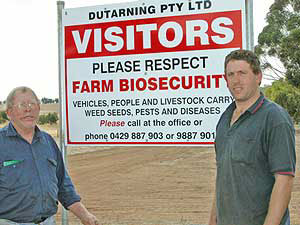Pingelly, Western Australia
April 22, 2004
|
Seeding is an important a good time to
consider biosecurity measures to protect the new season’s
crop and the long term productivity of a farming property.
Pingelly grain and seed producer, Ray
Marshall, who is one of the few growers to install
biosecurity signs on his property, said local measures
provide the best opportunity to protect a farm business.
“We are kicking off this season with a new
sign at our farm gate which alerts visitors to the
possibility that vehicles, people and livestock can
introduce weeds, pests or diseases on to the farm,” Mr
Marshall said.
“We ask all visitors to please call at our
office before moving around the farm.
“I genuinely believe straightforward and
easily-implemented biosecurity measures as part of day to
day farm management is the best approach to preventing
weeds, pests or diseases entering your property.”
|
 |
|
Pingelly grain and seed producers Ray
Marshall and son Andrew, have installed a biosecurity sign
on their property. |
Mr Marshall said seeding time posed its own risks
but once again common sense and effective biosecurity went hand
in hand.
He said when growers purchased seed, they should
understand if they bought seed lines from outside of their
district there was always a chance of introducing new weed
seeds.
“Seed suppliers should be asked for the Statement
of Seed Analysis that comes with the seed line. This includes
information on the cultivar name, percentage of pure seed and a
list of the weed seeds identified during seed analysis,” Mr
Marshall said.
“Growers should also be vigilant for weed seeds
in the bought line such as ryegrass or wild radish that are
prone to developing herbicide resistance.”
Department of Agriculture plant health manager
Shashi Sharma said farmers who adopted biosecurity principles
formed a valuable front line in protecting the State against the
introduction and spread of biological threats.
“This complements the quarantine work that
safeguards our agriculture industry from the introduction of
exotic biosecurity threats and helps maintain the quantity and
quality of our produce, while protecting our markets,” Dr Sharma
said.
Practical ways to introduce biosecurity to the
farm are described in Farmnote 41/2003, which is available from
Department offices or online at the Department’s website
www.agric.wa.gov.au (search on ‘practical farm
biosecurity’). A brochure on ’Smart seed buying’ is also
available from Department offices. |